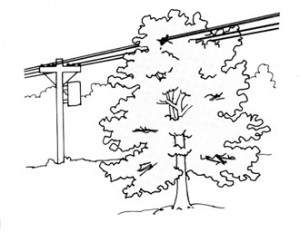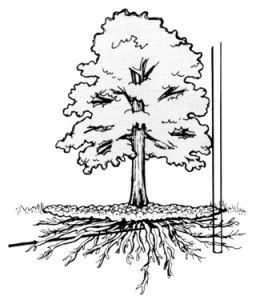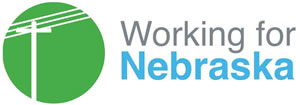Avoiding Tree & Utility Conflicts
Determining where to plant a tree is a decision that should not be taken lightly. Many factors should be considered prior to planting. When planning what type of tree to plant, remember to look up and look down to determine where the tree will be located in relation to overhead and underground utility lines.
 Often we take our electric utility services for granted because they have become a part of our daily lives. For us to enjoy the convenience of reliable, uninterrupted service, electric utility companies are required to bring utilities into our homes. These services arrive at our homes through overhead and underground lines. The location of these lines should have a direct impact on your tree and planting site selection. The ultimate, mature height of a tree to be planted must be within the available overhead growing space. Just as importantly, the soil area must be large enough to accommodate the particular rooting habits and ultimate trunk diameter of the tree. Proper tree and sight selection will provide trouble-free beauty and pleasure for years to come.
Often we take our electric utility services for granted because they have become a part of our daily lives. For us to enjoy the convenience of reliable, uninterrupted service, electric utility companies are required to bring utilities into our homes. These services arrive at our homes through overhead and underground lines. The location of these lines should have a direct impact on your tree and planting site selection. The ultimate, mature height of a tree to be planted must be within the available overhead growing space. Just as importantly, the soil area must be large enough to accommodate the particular rooting habits and ultimate trunk diameter of the tree. Proper tree and sight selection will provide trouble-free beauty and pleasure for years to come.
Overhead lines
Overhead utility lines are the easiest to see and probably the ones we take most for granted. Although these lines look harmless enough, they can be extremely dangerous. Planting tall growing trees under and near these lines will ultimately require your electric utility company to prune them to maintain safe clearance from the wires. This pruning may result in the tree having an unnatural appearance. Periodic pruning can also lead to a shortened life span for the tree. Trees which must be pruned away from power lines are under greater stress and more susceptible to insects and disease. Small immature trees planted today can become problem trees in the future. Tall growing trees near overhead lines can cause service interruptions when trees contact the wires. Children or adults climbing in these trees can be severely injured or even killed if they come in contact with the wires. Proper selection and placement of trees in and around overhead power lines can eliminate potential public safety hazards, reduce expenses for the power company and their rate payers and improve the appearance of landscapes.
Underground lines
 Trees are much more than what we see overhead. Many times the root area is larger than the branch spread above ground. Particularily in the urban areas, many of the electric lines are buried in the ground. Tree roots and underground lines often co-exist without problems. However, trees planted near underground lines could have their roots damaged if the lines need to be dug up for repairs. Consult your tree care professional or garden center staff for assistance in choosing the tree which will have the right type of root system for the location you have chosen.
Trees are much more than what we see overhead. Many times the root area is larger than the branch spread above ground. Particularily in the urban areas, many of the electric lines are buried in the ground. Tree roots and underground lines often co-exist without problems. However, trees planted near underground lines could have their roots damaged if the lines need to be dug up for repairs. Consult your tree care professional or garden center staff for assistance in choosing the tree which will have the right type of root system for the location you have chosen.
The biggest danger to underground lines occurs during planting. Before you plant, make sure you Call Before You Dig! Never assume that these electric lines are buried deeper than you plan to dig. In some cases electric lines can be very close to the surface.
Some further suggestions
Windbreaks
Plant evergreen trees on the west or north side of the house, approximately 50 feet (15M) or more from the house.
Temperature
Plant deciduous (autumn leaf-dropping) trees on the south and/or west side of the house to cool in the summer and allow sun to enter the house in the winter.
Planning before planting will help you to be sure that the right tree is planted in the right place. Proper tree selection and placement will enhance your property value and prevent costly maintenance trimming and damage to your home. Good landscaping utilizes shrubs and low-growing trees that are compatible with electric lines. They will not, therefore, create public safety hazards, cause service interruptions to you or your neighbors nor will they require severe pruning.
Printed with permission from the International Society of Arboriculture, Champaign, IL
 Want to avoid spending a day in the dark? It’s as simple as 8-1-1.
Want to avoid spending a day in the dark? It’s as simple as 8-1-1.
Call 811 from anywhere in the country a few days prior to digging, and your call will be routed to your local One Call Center. Tell the operator where you’re planning to dig, what type of work you will be doing and your affected local utilities companies will be notified about your intent to dig. In a few days, they’ll send a locator to mark the approximate location of your underground lines, pipes and cables, so you’ll know what’s below – and be able to dig safely.
Remember, always call 811 before you start any digging project! You’ll avoid injury, expense, embarrassment – and a very inconvenient day in the dark.
For more information on your local One Call Center, or to make an online request for utilities to be marked (where available), click here.

